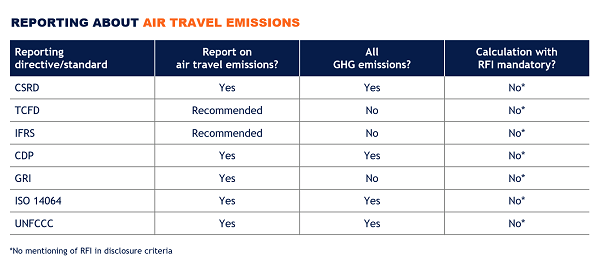
Should non-CO₂ effects be included in GHG calculation methods for business air travel?
How effectively are greenhouse gas (GHG) emissions in business air travel measured? Are the environmental consequences beyond CO₂ emissions adequately addressed? Answers to these questions and recommendations for improving current calculation methods used by travel agents, booking tools and corporate reporting standards are in this article.
July 2023 | Authors: Researched by Andreas Vandyck (Sustainability Consultant) and Isabel Alonso Vergés (Sustainability Consultant) and written by Lorna Tasker (Carbon Adviser) and Clarissa Schouten (Communications specialist). Source: website Climate Neutral Group
The aviation industry contributes to around 2% of global CO₂ emissions [1]. Without additional measures, this impact is expected to increase by twofold or even fourfold by the year 2050 [2]. However, these figures exclude the non-CO2 effects from air travel1.
Alongside CO₂ emissions, other non-CO₂ effects generated by aviation include water vapour, aerosols, nitrogen oxides and soot. CO₂ and non-CO₂ aviation emissions combined account for 3-4% of global GHG emissions [3].
Non-CO₂ effects have a substantial impact on the climate comparable to that of CO₂ emissions. Non-CO₂ effects should therefore be included in calculation methodologies to foster accurate reporting and monitoring, and the development of sound reduction strategies.
Typically, the estimation of non-CO₂ effects involves the application of a multiplier (or RFI) to CO₂ emissions. This approach helps quantify the additional climate impact caused by these non-CO₂ effects, ensuring a comprehensive assessment of the overall environmental footprint of air travel.
As companies recognise the importance of reporting scope 3 emissions, which includes business travel, there is a growing need for accurate methodologies to calculate the emissions associated with business air travel. By implementing reliable and standardised methods, companies can effectively measure and manage their carbon footprint, ultimately contributing to more sustainable practices within the aviation industry.
Adopting the Radiative Forcing Index
Recent research performed Climate Neutral Group (CNG) has shown that existing reporting standards fall short in adequately addressing the issue of non-CO₂ effects in GHG calculations, despite the fact that standards acknowledge their significance.

Currently, most GHG calculation methodologies only address CO₂ emissions. CNG’s research also found a lack of consistency in estimating the climate impact of non-CO₂ effects across the different calculation methodologies.
The Radiative Forcing Index (RFI) factor is an alternative approach to assess the additional climate impact of non-CO₂ effects in GHG, particularly in aviation. Due to the disparity in estimating the impact of non-CO₂ effects, there is widespread uncertainty about what RFI value to use, which had lead to the RFI factor not being fully adopted.
Recommendations
An international consensus on using an RFI factor of some kind (regardless of which value is chosen) in air travel GHG calculation methodologies could significantly improve measuring, reporting and reducing GHG emissions. Persuading policy makers to change regulations to include an RFI factor, would encourage the introduction of a standardised version and facilitate the inclusion of non-CO₂ effects in reporting frameworks.
Adding non-CO₂ effects into the calculation methods used by tools and explicitly mentioning the RFI factor used is a relatively simple change that could have a large impact on the effectiveness of reporting. Including the RFI factor as standard in tools used by travel agents and other booking tools, with an option to opt-out, would encourage wider adoption of this important metric.
A category dedicated to business air travel should be added to reporting standards. Although there is no consensus on the best way to report GHG emissions in business air travel, combining an RFI factor and a fuel-based calculation would significantly improve current practices and move towards more accurate reporting of non-CO₂ effects in business air travel. Most organisations are familiar with the UK BEIS methodology and it is widely accepted. BEIS recommends 1.7 RFI [4] in the conversion factors for 2023, and although this is lower than other calculation methods that use 2.5, 2.7 and 3, we believe this slightly more conservative RFI value is more likely to be accepted as a standard. Making the 1.7 RFI mandatory when using the Beis method, is a small step that would have a large impact, given the number of organisations using this calculation method.
Additionally, compliance with the EU’s Corporate Sustainability Reporting Directive (CSRD) and specifying business air travel emissions would contribute to a more transparent and detailed reporting process.
Climate Neutral Group (CNG) helps organisations gain insight into the impact of their air travel on the environment through carbon footprinting. CNG’s Flight Carbon Calculator uses a fuel-based methodology with an RFI and is approved by the Carbon Offsetting Quality Assurance Scheme from the UK.
CNG offers advice on reducing travel emissions through our Travel Scan Service and provides high quality offsetting for remaining emissions from certified climate projects from our chosen portfolio. For more information about these services, please contact info@climateneutralgroup.com and quote this article.
References
[1] Aviation – Analysis – IEA | carbonbrief.org/explainer-challenge-tackling-aviations-non-co2-emissions
[2] ENVReport2022_Art7.pdf (icao.int)
[3] ourworldindata.org/co2-emissions-from-aviation
[4] The UK BEIS RFI was amended on 7 June 2023 to 1.7 in the conversion factors 2023. The UK BEIS RFI conversion factor for 2022 was 1.9.


